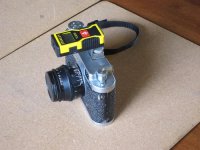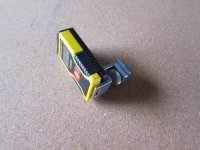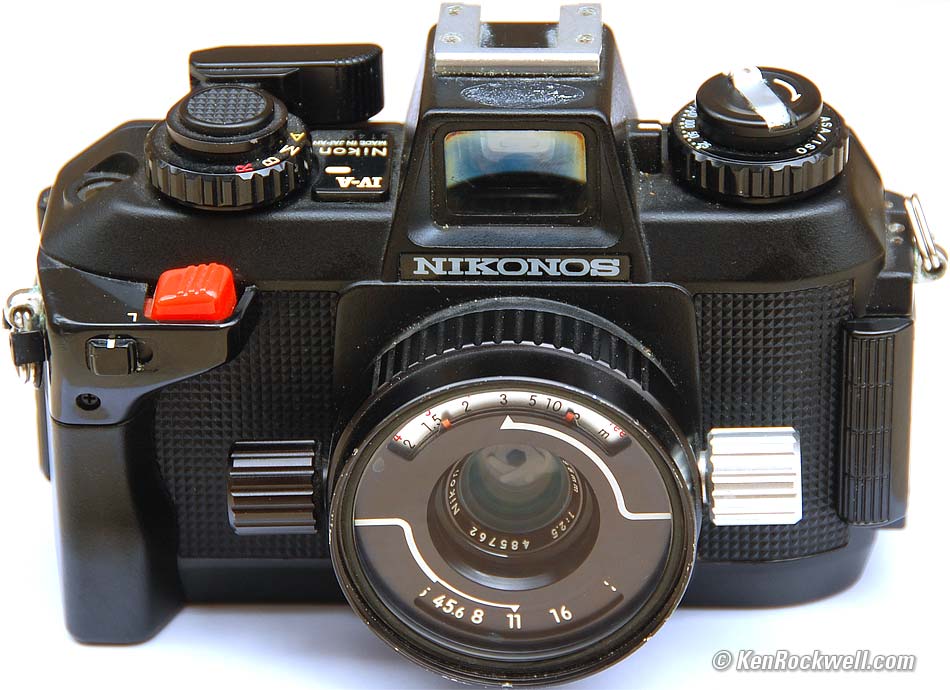bmattock
Veteran
All:
Sorry for the lengthy post - I wanted to explain the method to my madness...
Since I collect not just new and not just old but REALLY old rangefinder (and direct-view) cameras and like to take them out and take photos with them, I am always on the lookout for ways to make my photography easier and more enjoyable.
Some of my elderly cameras either don't have rangefinders, or they're broken, or they're just too dim with age, etc. And my vision is not what it was, either.
I have obtained some of the vintage external rangefinders that one finds on eBoy, made by Kodak, Voigtlander and others. These are quite small and fit into a shirt pocket, or they attach to the flash acccessory shoe on the camera. You read them just like any coincident rangefinder, but then you transfer the distance reading to your lens and away you go. These generally work OK, but they're elderly and don't have the world's greatest viewfinders either. And worse, I've got about five of them - they disagree on the distance to things I want to photograph. I could measure off the actual distances and adjust them, of course...but I'm so lazy...
I have gotten better at manually judging distances - and I am getting better at guestimating what the approximate depth-of-focus for a given lens at a given aperture would be, and this gives me a range for error that often works pretty well.
But there are times when I really want to nail the distance, and (assuming that my lens is calibrated properly for distance), use a really open aperture to give maximum out-of-focus effects an all but my chosen subject.
I could bring a measuring tape - this would work fine in many circumstances. I could use a string with known distances marked on it or knotted in the cord - an old trick that still works well. I could guess the distance. I could pace it off and count my footsteps.
But I guess I think it would be cool if I could just stand where I am and get a really accurate distance reading. Just to get one variable out of the way, anyhow, with a minimum of fuss.
I thought about the types of 'rangefinder' that are sold today. These are primarily used for things like golfing, hunting, bow hunting, and general contracting. They're not that much use for a shutterbug, since they are more interested in distances beyond what we'd set as 'infinity' on our lenses - and their factor of error is well beyond what we'd consider acceptable anyway. And some of them cost the world anyhow.
But I found this:
http://www.sonin.com/lasertarget.html
I thought it just might be useful for me. Looks like it goes for about $49 mailorder, uses a 9-volt battery, and measures what I'd consider a useful distance - 1.5 feet to 60 feet. It will display in feet/inches or meters or yards. Uses a visible laser so you can see what you're getting your distance from.
Drawbacks? Well, one more thing to carry around. It's small, but not tiny. Doesn't look like something I could clip on a camera accessory shoe. Apparently, it gets distance from flat objects better than objects with lots of craggy nooks, and clothing, etc. I'd have to test it to see how well it did outdoors in daylight. And of course, with the laser pointer, you'd have to be really careful not to point it at people - so using it for portraits would require some care (like telling your subject to close his/her eyes for a moment). And I guess I'd be very careful not to shine it in any airliner cockpits (!).
But it might be worth a try. I think I'm going to order one, I'll test it out and let people know how it works out. But I thought I'd pass on the information in case anyone else feels like experimenting too.
Best Regards,
Bill Mattocks
Sorry for the lengthy post - I wanted to explain the method to my madness...
Since I collect not just new and not just old but REALLY old rangefinder (and direct-view) cameras and like to take them out and take photos with them, I am always on the lookout for ways to make my photography easier and more enjoyable.
Some of my elderly cameras either don't have rangefinders, or they're broken, or they're just too dim with age, etc. And my vision is not what it was, either.
I have obtained some of the vintage external rangefinders that one finds on eBoy, made by Kodak, Voigtlander and others. These are quite small and fit into a shirt pocket, or they attach to the flash acccessory shoe on the camera. You read them just like any coincident rangefinder, but then you transfer the distance reading to your lens and away you go. These generally work OK, but they're elderly and don't have the world's greatest viewfinders either. And worse, I've got about five of them - they disagree on the distance to things I want to photograph. I could measure off the actual distances and adjust them, of course...but I'm so lazy...
I have gotten better at manually judging distances - and I am getting better at guestimating what the approximate depth-of-focus for a given lens at a given aperture would be, and this gives me a range for error that often works pretty well.
But there are times when I really want to nail the distance, and (assuming that my lens is calibrated properly for distance), use a really open aperture to give maximum out-of-focus effects an all but my chosen subject.
I could bring a measuring tape - this would work fine in many circumstances. I could use a string with known distances marked on it or knotted in the cord - an old trick that still works well. I could guess the distance. I could pace it off and count my footsteps.
But I guess I think it would be cool if I could just stand where I am and get a really accurate distance reading. Just to get one variable out of the way, anyhow, with a minimum of fuss.
I thought about the types of 'rangefinder' that are sold today. These are primarily used for things like golfing, hunting, bow hunting, and general contracting. They're not that much use for a shutterbug, since they are more interested in distances beyond what we'd set as 'infinity' on our lenses - and their factor of error is well beyond what we'd consider acceptable anyway. And some of them cost the world anyhow.
But I found this:
http://www.sonin.com/lasertarget.html
I thought it just might be useful for me. Looks like it goes for about $49 mailorder, uses a 9-volt battery, and measures what I'd consider a useful distance - 1.5 feet to 60 feet. It will display in feet/inches or meters or yards. Uses a visible laser so you can see what you're getting your distance from.
Drawbacks? Well, one more thing to carry around. It's small, but not tiny. Doesn't look like something I could clip on a camera accessory shoe. Apparently, it gets distance from flat objects better than objects with lots of craggy nooks, and clothing, etc. I'd have to test it to see how well it did outdoors in daylight. And of course, with the laser pointer, you'd have to be really careful not to point it at people - so using it for portraits would require some care (like telling your subject to close his/her eyes for a moment). And I guess I'd be very careful not to shine it in any airliner cockpits (!).
But it might be worth a try. I think I'm going to order one, I'll test it out and let people know how it works out. But I thought I'd pass on the information in case anyone else feels like experimenting too.
Best Regards,
Bill Mattocks






